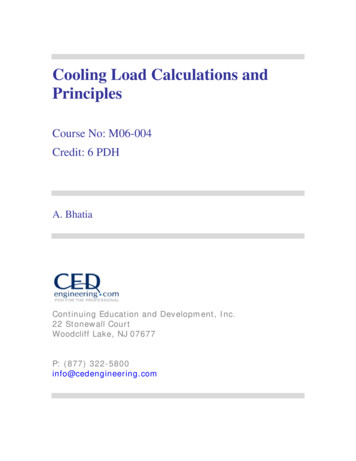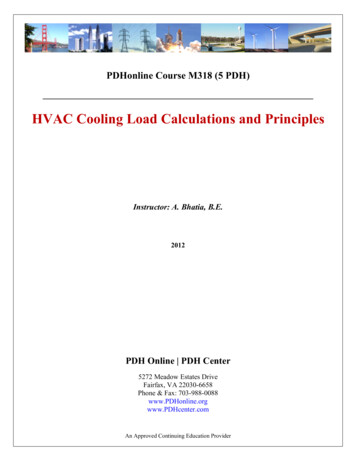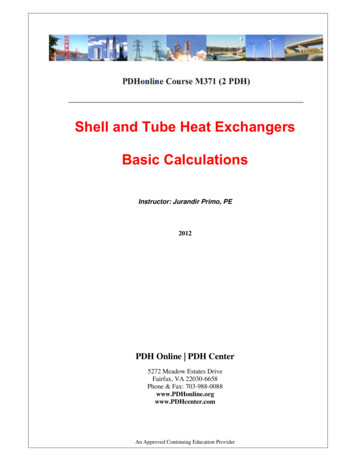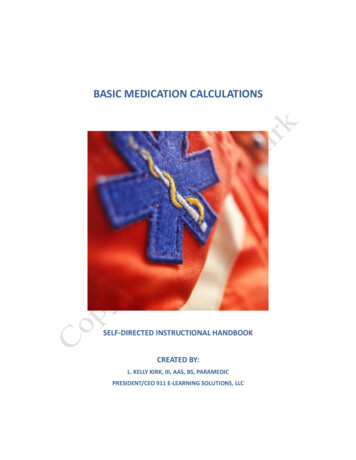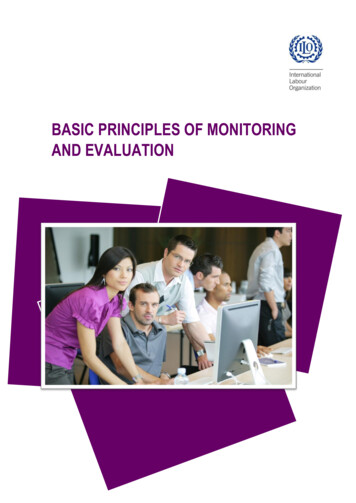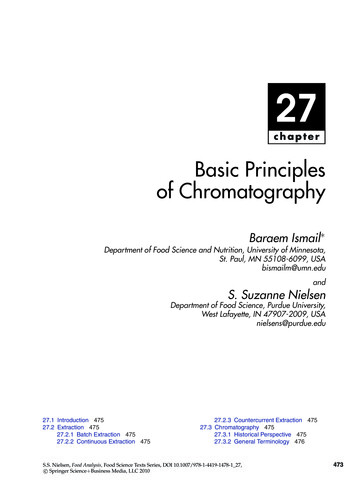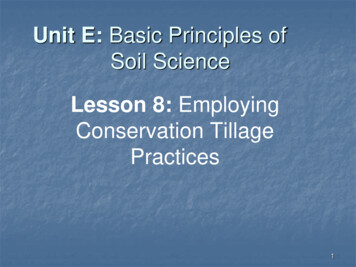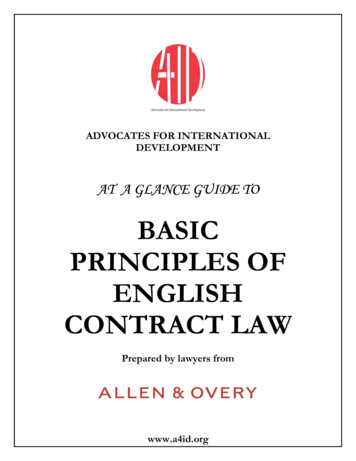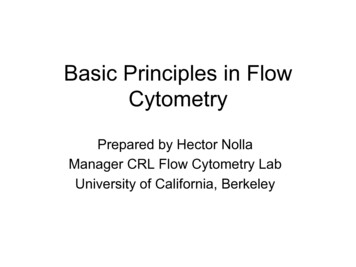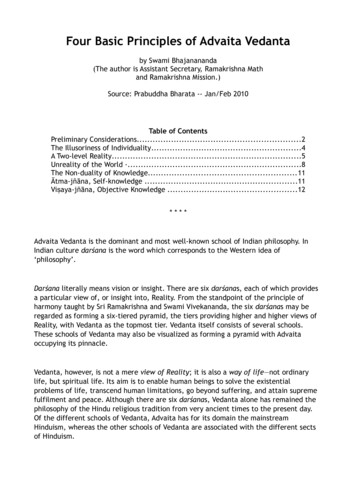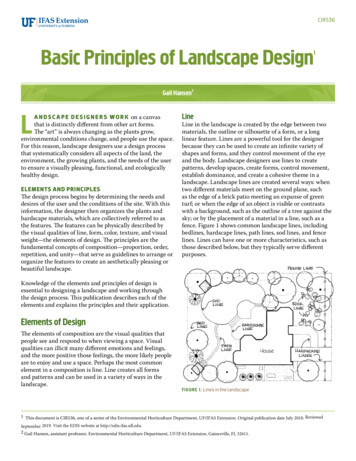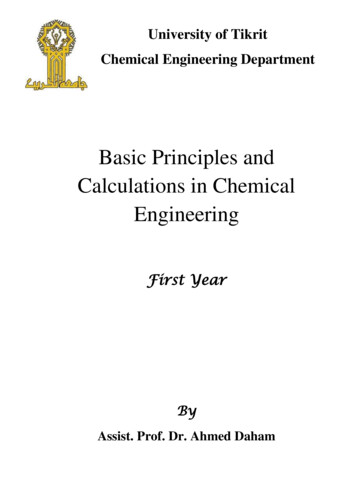
Transcription
University of TikritChemical Engineering DepartmentBasic Principles andCalculations in ChemicalEngineeringFirst YearByAssist. Prof. Dr. Ahmed Daham
Basic PrinciplesFirst YearAsst. Prof. Dr. Ahmed DahamPart 2Material BalancesChapterPage6Introduction to Material Balance1337General Strategy for Solving Material Balance Problems1668Solving Material Balance Problems for Single Units 196Without Reaction9The Chemical Reaction Equation and Stoichiometry22510Material Balances for Processes Involving Reaction26011Material Balance Problems Involving Multiple Units30512Recycle, Bypass, and Purge and the Industrial Application 341of Material BalancesChapter 6Introduction to Material Balance:Material balance involves calculations the quantities of all materials that enter andleave any system or process which are based on the principle of the "law of conversation ofmass". This law states that matter is neither created nor destroyed in the process and the totalmass remains unchanged. The general principle of material balance calculations is to put andsolve a number of independent equations involve number of unknowns of compositions andmass flow rates of streams enter and leave the system or process.The process can be defined as one or a series of operations in which physical and chemicaltreatments are carried out and a desired product is result in the end such as distillation, drying,absorption, chemical manufacture, etc.The system can be defined as any arbitrary portion of a process that you want to consider foranalysis such as a reactor. The system boundary must be fixed in each problem by drawingan imaginary boundary around it as shown in the following figure:2
Basic PrinciplesFirst YearAsst. Prof. Dr. Ahmed DahamThere are two important classes of systems:1.Closed system:The material neither enters nor leaves the vessel (system), as shown below:Figure 1: Closed system2.Open system (flow system):The material cross the system boundary, as shown below:Figure 1: Open system (Flow system)The chemical processes can be classified as batch, continuous and semi-batch:1.Batch process:The feed materials are placed into the system (reactor, mixer, filter, .etc) at thebeginning of the process. These materials are held for a period of time known as "residencetime" or " retention period" during which the required physical and/or chemical changes areoccurred. The products are removed all at once after this time. No masses crossed the systemboundary during this time. Batch process fall into the category of closed systems.The basis used in such processes is usually "one batch", and the material balance forphysical batch processes in which there is no chemical reaction can be written as:Input(Initial quantity) 3Output(Final quantity)
Basic PrinciplesFirst YearAsst. Prof. Dr. Ahmed DahamThis equation can be applied for every substance (component balance) or for total materials(total material balance).Figure 2: The initial state of a batchmixing processFigure 3: The final state of a batchmixing process2.Semi-batch process:A semi-batch reactor of stirred type tank as shown in the Figure 4, often used for itsown particular characteristics. In this type, all quantity of one reactant is initially put in thereactor, and then other reactants are continuously fed. Only flows enter the systems, and noleave, hence the system is an unsteady state. This arrangement is useful when the heat ofreaction is large. The heat evolved can be controlled by regulating the rate of addition of oneof the reactants.Figure 4: Semi-batch reactor (Stirred type reactor)4
Basic PrinciplesFirst YearAsst. Prof. Dr. Ahmed Daham3.Continuous process (Flow process):The input and output materials are continuously transferred across the system boundary;i.e. the feed continuously enters the system and the product continuously leaves the system.The physical and/or chemical changes take place during the flow of materials through theeffective parts of equipments (packing, sieve plate, filter cloth, etc). A convenient period oftime such as minute, hour, or day must chosen as a basis over which material balancecalculations be made.This type of processes can be classified as "steady state" and "unsteady state"processes.a-Steady state process:The steady state process can be defined as that process in which all the operatingconditions (temperature, pressures, compositions, flow rate, .etc.) remains constant withtime. In such process there is no accumulation in the system, and the equation of materialbalance can be written as:Input OutputFigure 5: Steady state systemb-Unsteady state process:For an unsteady state process, not all of the operating conditions in the process (e.g.,temperature, pressure, compositions, flow rate, etc.) remain constant with time, and/or theflows in and out of the system can vary with time, hence the accumulation of materials withincan be written as follows:Input- Output Accumulation5
Basic PrinciplesFirst YearAsst. Prof. Dr. Ahmed DahamFigure 6: Initial conditions for an openunsteady state system with accumulation.Figure 7: The condition for the openunsteady state system with accumulationafter 50 min.Figure 8: Initial conditions for anunsteady state process with negativeaccumulation.Figure 9: Condition of the open unsteadystate system with negative accumulationafter 50 min.Remarks:1.2.3.4.By their nature, batch and semi-batch processes are unsteady state operations since theconcentration within the closed system is continuously changed with time.Continuous processes are usually runs as close as possible to the steady state by usingsuitable control units. However, unsteady state (transient) conditions exist during thestart up of a process. All material balance and design calculations are done for steadystate conditions.Batch processes are commonly used for small scale processes in which relatively smallquantities of a product are to be produced, while continuous process is better suited tolarge production rates.All material balance calculations in this chapter are made on steady state processes inwhich the accumulation term is zero. However, material balance on a batch processcan be made over a residence time and on the basis of one batch ( integral balance).6
Basic Principles5.First YearAsst. Prof. Dr. Ahmed DahamCalculations of unsteady state processes are somewhat more complicated than that ofthe steady state processes since involving differential equations which can be solve byintegration. These calculations with their applications in many chemical engineeringfields ( mass transfer, heat transfer, chemical kinetics, etc.) will be given in "AppliedMathematics in Chemical Engineering" within 3rd year of study.Chapter 7A general Strategy for Solving Material Balance ProblemsThe strategy outlined below is designed to focus your attention on the main path rather thanthe detours:1.2.3.Read and understand the problem statementThis mean read the problem carefully so that you know what is given and what is to beaccomplished.Draw a sketch of the process and specify the system boundaryDraw a simplified imaginary sketch (block diagram) or a flow sheet or process flowdiagram (PFD) consists of boxes which represent equipments, and lines which indicateall streams enter and leaves each equipment.Label the flow of each stream and the associated compositions with symbolsPut a letter as a symbol stream such as (F) for feed stream, (P) for product stream .etc.Furthermore, put all the known values of compositions and stream flows on the figureby each stream; calculate additional compositions from the given data as necessary.7
Basic PrinciplesFirst YearAsst. Prof. Dr. Ahmed DahamExample 7.2: A continuous mixer mixes NaOH with H2O to produce an aqueous solution ofNaOH. Determine the composition and flow rate of the product if the flow rate of NaOH is1000 kg/hr, and the ratio of the flow rate of the H2O to the product solution is 0.9.We will use this example in subsequent illustrations of the proposed strategy. For thisexample, just a sketch of the process is required.4.5.6.7.Write additional data required to solve the problem and the chemical equations if theprocess involves chemical reaction.Select a suitable basis of calculations.List by symbols each of the unknown values of the stream flows and compositionsMake a number of independent material balances equations equal to unknownquantities to be calculated. It is important to put these equations in proper sequence sothat the first one content only one unknown in order to avoid complicated solution ofthe simultaneous equations. Three type of material balance equations can be formulated:a.b.c.8.Equation for total quantities which is called (total material balance) or (over allmaterial balance).Equation for each component which is called (component material balance). Ifthere is no chemical reaction the number of equations that can be written is equalto the number of components in the system.Equation for each element which is called (element material balance) if there isa chemical reaction.The existence of a substance that enters in one inlet stream and leaves in one outletstream with known compositions and it passes unchanged through the process unit(inert for chemical reaction) is greatly simplified material balance calculations. Thissubstance is termed as (tie component). It is important to search for the existence of atie component and formulate a material balance equation. Nitrogen is considered as a tiecomponent in handling of combustion calculations. Since it is input within air stream,8
Basic Principles9.First YearAsst. Prof. Dr. Ahmed Dahamunreacted, and out with the exit flue gases. If there are more than on tie component inthe same input and output streams, these components can be made on (over all tiecomponents material balance).Check your answers by introducing them, or some of them, into the material balanceequations. Are the equations satisfied? Are the answers reasonable?Chapter 8Solving Material Balance Problems for Single UnitsWithout Reaction1.Mixer unit:Example: It is required to prepare 1250 kg of a solution composed of 12 wt.% ethanol and88 wt.% water. Two solutions are available, the first contains 5 wt.% ethanol, and the secondcontains 25 wt.% ethanol. How much of each solution are mixed to prepare the desiredsolution?Solution:1.Ethanol balanceInput output52512A 100 B(100 ) M (100 )0.05 A 0.25 B 0.12 MA 2.150 0.25 B 3000 5 𝐵 . . (𝟏)0.05Water balanceInput output0.95 A 0.75 B 0.88 M 0.88 1250 11000.95 A 0.75 B 1100 . . (𝟐)Sub. (1) in (2)0.95(300-5 B) 0.75 B 11002850 - 4.75 0.75 B 11004 B 1750 .B 437.5 kgSub. B in (1) :A 3000 – 5(437.5) 812.5 kg3.Checking: Total material balance (T.M.B.), Input A B 437.5 812.5 1250 kgOutput M 1250 kg9
Basic Principles2.First YearAsst. Prof. Dr. Ahmed DahamExtraction unit:Example 8.1: Extraction of Streptomycin from a Fermentation Broth:Streptomycin is recovered by contacting the fermentation broth with an organic solventin an extraction process. The extraction process is able to recover the Streptomycin becauseStreptomycin has a greater affinity for dissolving in the organic solution than in the aqueoussolution. Figure E8.1 shows the overall process. Determine the mass fraction of Streptomycinin the exit organic solvent assuming that no water exits with the solvent and no solvent exitswith the aqueous solution. Assume that the density of the aqueous solution is 1 g/cm3 and thedensity of the organic solvent is 0.6 g/cm3.Mass fraction of Strep. ?Solution:This is an open (flow), steady-state process without reaction. Assume because of thelow concentration of Strep. In the aqueous and organic fluids that the flow rates of theentering fluids equal the flow rates of the exit fluids.Basis: 1 min10
Basic Principles3.First YearAsst. Prof. Dr. Ahmed DahamMembrane unit:Example 8.2: Separation of Gases Using a Membrane:Membranes represent a relatively new technology for the separation of gases. One usethat has attracted attention is the separation of nitrogen and oxygen from air. Figure E8.2aillustrates a nanoporous membrane that is made by coating a very thin layer of polymer on aporous graphite supporting layer. What is the composition of the waste stream if the wastestream amounts to 80% of the input stream?Solution:This is an open, steady-state process without chemical reaction. The system is themembrane as depicted in Figure E8.2. Let yO2 be the mole fraction of oxygen as depicted inFigure E8.2, yN2 be the mole fraction of nitrogen, and let nO2 and nN2 be the respective moles.Basis: F 100 gmoleInput OutputF P WW 80% F 0.8 x 100 80 gmoleP 20 gmole11
Basic PrinciplesFirst YearAsst. Prof. Dr. Ahmed Dahamgmolegmole 5 gmole 15 gmoleOxygen Material Balance (O2 M.B):gmoleNitrogen Material Balance (N2 M.B):gmoleMole fraction of O2 in waste,Mole fraction of N2 in waste,4.yO𝑊2 yN𝑊2 1616 646416 64 0.2 0.8Distillation column:Example : Overall Analysis for a Continuous Distillation Column:A binary mixture consists of 35 % benzene and 65 % toluene are continuously fed to thedistillation column at a rate of 1000 kg/hr. Whereas, the distillate flow rate was 10% from thefeed flow rate. The distillate (top product) contains 85 % benzene. Calculate quantity andcompositions of the waste stream.Solution:Although the distillation unit shown in Figure below is comprised of more than one unitof equipment, you can select a system that includes all of the equipment inside the systemboundary. Consequently, you can ignore all the internal streams for this problem.Basis: 1 hrF 1000 kgP (10 /100) of Feed 0.1 x (1000) 100 kgOverall Material Balance:Input OutputF P W1000 100 W12W 900 kg
Basic PrinciplesFirst YearAsst. Prof. Dr. Ahmed DahamBenzene Material Balance:(0.35) (1000) (0.85) (100) Kg of benz. in (W)350 85 Kg of benz. in (W)Kg of benz. in (W) 265 kgToluene
Solving Material Balance Problems for Single Units Without Reaction 1. Mixer unit: Example: It is required to prepare 1250 kg of a solution composed of 12 wt.% ethanol and 88 wt.% water. Two solutions are available, the first contains 5 wt.% ethanol, and the second contains 25 wt.% ethanol. How much of each solution are mixed to prepare the desired
